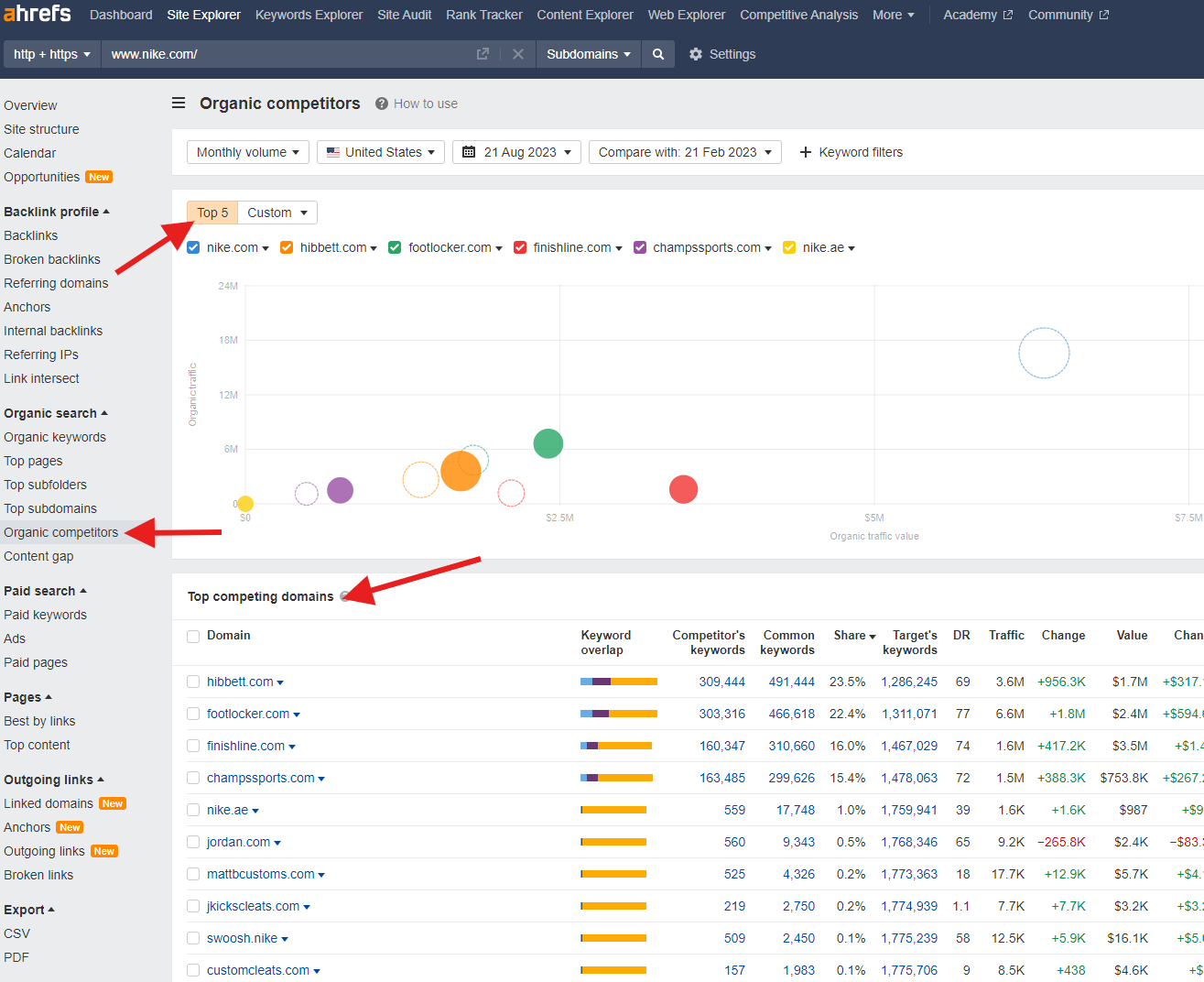Search engine optimization (SEO) is an inherently competitive activity.
For every popular search term, there are countless websites vying for the top spot in Google’s rankings.
And since the top three placements in Google’s results pages receive a staggering 77% of all organic clicks, it’s easy to see why competition is so fierce.
One of the best ways to increase your organic search presence is to regularly seek out SEO competitive insights.
Studying what works well for your SEO rivals and identifying their weaknesses can help you finetune your own strategy for a greater competitive edge.
This post will teach you how to analyze your competitors’ SEO strategies so you can discover new opportunities to overtake them in the search results.
Why Competitive Insights In SEO Matter
We’re all familiar with the well-known idiom “know your enemy.”
The idea is that understanding your opponent’s strengths, weaknesses, and tactics can help you find ways to navigate the competitive landscape more effectively.
Organic search is no different. You can learn a lot about how to achieve your SEO goals by analyzing high-ranking competitors.
After all, if a competitor is consistently outranking you, they must be doing something right. And once you figure out what that “something” is, you can apply it to your own SEO strategy.
Likewise, if you discover that a competitor’s approach falls short in some way, you can capitalize on the opportunity to do it better.
And the best news? All it takes to find valuable SEO competitive insights is a little detective work.
How To Gather SEO Competitive Insights In 5 Steps
Now let’s look at the main steps involved in extracting insights from your competitors’ search activities.
1. Define The Competition
The first step is to identify your SEO competitors.
No doubt you already know who your traditional business rivals are, but remember these may differ from your actual search competitors. The internet is a big place, after all.
The simplest way to figure out who you’re competing against is to search Google for the type of terms you want to rank for and take note of the sites that consistently appear.
For example, suppose you wanted to rank for the term [men jordans low]. In that case, your SEO competitors would include Nike, Foot Locker, and Farfetch.
 Screenshot from search for [men jordans low], Google, August 2023
Screenshot from search for [men jordans low], Google, August 2023You should also check the competition for location-based searches if your business serves customers in a particular geographic area.
Let’s say you run a boxing gym in Nashville. Here’s what your local SEO competition looks like.
 Screenshot from search for [nashville boxing gym], Google, August 2023
Screenshot from search for [nashville boxing gym], Google, August 2023Bonus Tip: Instead of looking at individual keywords to see who is ranking, you can also use Ahrefs and navigate to Site Explorer > Organic Competitors. This shows competing websites that rank in the top 10 organic search results for the same keywords that your target gets the most traffic from.
See the example below:
 Screenshot from Ahrefs, August 2023
Screenshot from Ahrefs, August 20232. Analyze Their Keyword Strategy
Now that you know who your competitors are, the next step is to build a full picture of the keywords they’re ranking for. This exercise will help you identify new terms that you should be targeting.
The most efficient way to approach competitor keyword research is to use a dedicated SEO competitor analysis tool, like Semrush or Ahrefs. Note that these tools require a paid subscription (although Semrush does offer a 14-day free trial).
To get a comprehensive list of a competitor’s keywords in Semrush, head to “Organic Research” and enter your competitor’s domain name.
 Screenshot from Semrush, August 2023
Screenshot from Semrush, August 2023
In the dashboard, you’ll see a section labeled Top Keywords, which you can expand by clicking View all keywords.
Here’s an example from nike.com.
 Screenshot from Semrush, August 2023
Screenshot from Semrush, August 2023
You can then export the keyword list into a spreadsheet and filter out any branded terms (for example, any terms containing the brand phrase “Nike”).
This will leave you with a full list of all the non-branded keywords your competitor ranks for, including monthly search volumes and a link to each ranking page.
Once you repeat the process for all your main competitors, you can compare the data with your own ranking keywords and identify any terms you don’t yet rank for.
Keep an eye out for any high-volume terms that only one or two competitors target. These will often be easier for you to rank for.
You should review each keyword individually and consider whether it’s appropriate for your business. If it’s a good fit, you should target it!
3. Assess Their Content Strategy
Knowing which keywords you should target is one thing. Knowing how to target them is another thing entirely.
This is why the next step is to examine the competitor content that performs well for your desired terms so you know what it takes to rank for them.
The first thing to consider for each keyword is the content type.
Is it presented as a long-form how-to guide? An infographic? A video?
And what about the depth and breadth of the content? Does it cover subtopics or only stick to the core subject area?
Remember, Google invests a lot of time and energy into serving users results that best match their search intent. For this reason, the top-ranking results are an excellent guide to how you should approach your own content.
Finally, you should study how successful competitors have optimized their on-page elements for the keyword in question.
Chances are, the keyword will appear in the URL, page title, H1 header tag, and throughout the body copy. Be sure to note the use of any keyword variations so you can incorporate them into your own content.
4. Conduct A Competitor Backlink Analysis
It’s impossible to overstate the importance of backlinks for SEO.
Not only do they send qualified referral traffic your way, but they also indicate to Google that your site is trustworthy and authoritative. The more high-quality links you get from other sites, the easier it is to rank.
Understanding which sites link to your high-ranking competitors will help you develop a roadmap for your own link-building strategy.
There are several tools you can use to conduct a competitor backlink analysis, including Ahrefs and Moz Link Explorer.
Once again, these tools require a paid subscription to access comprehensive datasets, but some also give you a free snapshot of the links pointing to your competitor sites.
For example, Ahrefs’ free backlink checker provides the top 100 backlinks for any domain, including the referring page, anchor, and target URL.
 Screenshot from Ahrefs, August 2023
Screenshot from Ahrefs, August 2023
Once you’ve finished exporting your competitors’ backlink data, it’s time to work through the list and highlight any authoritative, niche-relevant domains that come up.
These sites will be your prime candidates for link-building outreach. Since they’ve already linked to your competitor’s content, they may well be prepared to link to yours.
For example, if one of your shortlisted websites links out to a broken page or an outdated piece of content – and you have a better, more up-to-date resource – you could reach out to the website owner or editor to suggest a replacement.
5. Evaluate Your Competitors’ User Experience
The next tip for uncovering SEO competitive insights is to assess how your high-performing competitors deliver a positive user experience to their visitors.
Remember that page experience is a signal used by Google to determine where your site should rank in its search results.
The most important UX performance metrics to consider are the so-called “Core Web Vitals,” which include page load speed and the interactivity and visual stability of on-page elements.
Put simply, the faster your site loads, and the more responsive it is to user inputs, the better the user experience will be.
You can compare your site’s user-friendliness with your competitors by entering their domain name into Google’s free PageSpeed Insights tool. Remember that your site should work just as well on mobile as it does on desktop devices.
 Screenshots from PageSpeed Insights, August 2023
Screenshots from PageSpeed Insights, August 2023
Site structure and navigability are also essential considerations for website usability.
If your site is organized confusingly and makes visitors click several times to find the page they want, you need to address the issue as a priority.
On the other hand, if your competitors outrank you even though their sites are also poorly structured, there’s a good chance that you’ll gain ground in the search results by tidying up your site.
Final Thoughts
Researching your competitors’ organic search strategies can be a shortcut to building a more effective SEO campaign.
Once you understand why other websites excel compared with yours, you can take steps to reverse-engineer their success by incorporating similar tactics on your own site.
By following the steps outlined above, you’ll be well on your way to developing a high-performing SEO strategy.
Now go out there and uncover some insights!
More resources:
- Competitive Analysis: A Comprehensive 9-Step Guide
- 10+ Tools You Can Use for SEO Competitive Analysis
- Competitor Mapping: What Is It & How To Do It
Featured Image: tavan150/Shutterstock





